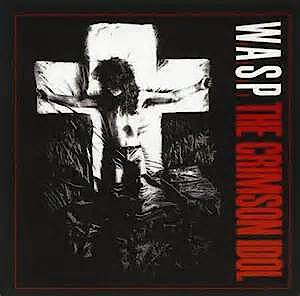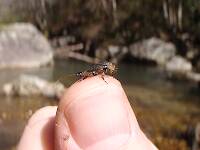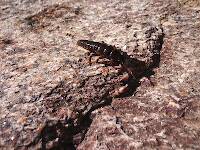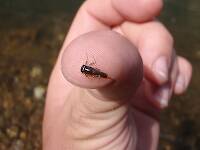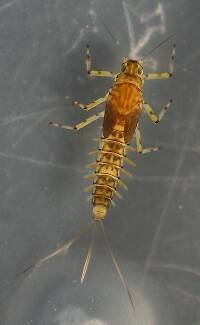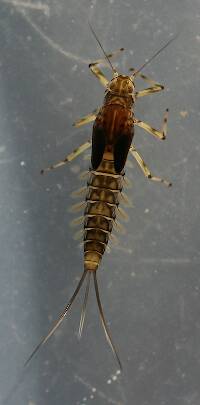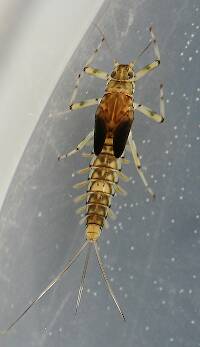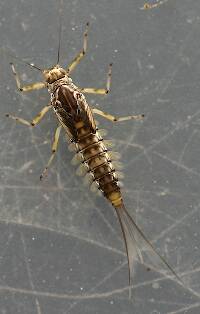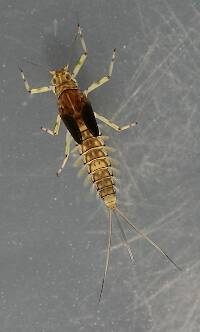
Blue-winged Olives
Baetis
Tiny Baetis mayflies are perhaps the most commonly encountered and imitated by anglers on all American trout streams due to their great abundance, widespread distribution, and trout-friendly emergence habits.
Featured on the forum


Troutnut is a project started in 2003 by salmonid ecologist Jason "Troutnut" Neuswanger to help anglers and
fly tyers unabashedly embrace the entomological side of the sport. Learn more about Troutnut or
support the project for an enhanced experience here.
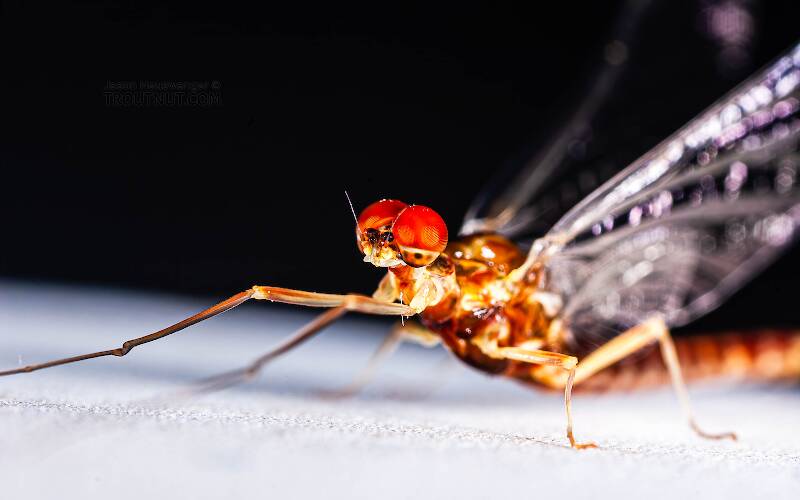
This spinner molted from a dun after being photographed, and the dun form is listed here as a separate specimen. I've rarely found a more cooperative and photogenic mayfly.
Troutnut on Jul 16, 2011July 16th, 2011, 2:17 am EDT
Gotta love Ephemerella spinners! I was thrilled that this one emerged and molted intact, and then behaved so well in front of the camera.
Jason Neuswanger, Ph.D.
Troutnut and salmonid ecologist
Troutnut and salmonid ecologist
Adirman on Jul 16, 2011July 16th, 2011, 3:02 am EDT
How do you tell the difference between the aurivillii and subvaria species? They look so much alike I wonder how you tell them apart? Also, if trout were feeding on the villi species, Hendricksons and Red Quills would probably work to fool 'em, right?
Thanks,
Adirman
Thanks,
Adirman
Troutnut on Jul 16, 2011July 16th, 2011, 4:08 am EDT
The aurivillii mayflies seem to be slightly smaller than subvaria, so I think smallish Hendrickson and Red Quill patterns would work pretty well. It's hard to officially tell the adults apart without getting the nether regions of a male spinner under a microscope, but there are some superficial differences in the ones I've seen. Compare this guy to a male Hendrickson spinner and you see the Hendrickson is a more uniform color, while aurivillii is more distinctly banded, fading to gray toward the back of each abdominal segment. Also, when you look at aurivillii adults from the top, you can see faint reminders of the vivid stripe they had as nymphs. I don't know if these visual characteristics are always reliable, but they hold up for the ones on this site at least.
Jason Neuswanger, Ph.D.
Troutnut and salmonid ecologist
Troutnut and salmonid ecologist
Entoman on Jul 16, 2011July 16th, 2011, 8:11 am EDT
A-man
First off, ditto Jason's comments. I just want to add that we've never seen photos of the duns before nor looked at them in the field knowing what we had in our hands. If it wasn't for Jason's tank rearing that allowed association with the nymphs we would still be in the dark regarding the duns. Since we had no idea what they looked like in the first place, we haven't had to deal with telling them apart from E. subvaria.:)
Regards,
Kurt
They look so much alike I wonder how you tell them apart?
First off, ditto Jason's comments. I just want to add that we've never seen photos of the duns before nor looked at them in the field knowing what we had in our hands. If it wasn't for Jason's tank rearing that allowed association with the nymphs we would still be in the dark regarding the duns. Since we had no idea what they looked like in the first place, we haven't had to deal with telling them apart from E. subvaria.:)
Regards,
Kurt
"It's not that I find fishing so important, it's just that I find all other endeavors of Man equally unimportant... And not nearly as much fun!" Robert Traver, Anatomy of a Fisherman
GONZO on Jul 16, 2011July 16th, 2011, 9:20 am EDT
A-man,
If my assumptions about the emergence timing of E. aurivillii in the East are correct (see my comments/questions in the 4th post on the third page here: http://www.troutnut.com/topic/3354/3/Grayling-fishing-and-bug-collecting-at-Nome-Creek#22077), the practical streamside problem for Eastern fly fishers might not be distinguishing them from Hendricksons (E. subvaria) so much as distinguishing them from the Large Early Sulphurs (E. invaria). I suspect that they might emerge after the Hendricksons, but distinguishing them from the Early Sulphurs could also be a bit tricky, especially the females (see Jason's photo of the female dun: http://www.troutnut.com/specimen/961).
If my assumptions about the emergence timing of E. aurivillii in the East are correct (see my comments/questions in the 4th post on the third page here: http://www.troutnut.com/topic/3354/3/Grayling-fishing-and-bug-collecting-at-Nome-Creek#22077), the practical streamside problem for Eastern fly fishers might not be distinguishing them from Hendricksons (E. subvaria) so much as distinguishing them from the Large Early Sulphurs (E. invaria). I suspect that they might emerge after the Hendricksons, but distinguishing them from the Early Sulphurs could also be a bit tricky, especially the females (see Jason's photo of the female dun: http://www.troutnut.com/specimen/961).
Oldredbarn on Jul 16, 2011July 16th, 2011, 12:27 pm EDT
Great stuff Jason! Those photos are wonderful. If you get a moment maybe you can tell us about or show us some of your equipment and how you pulled off such incredible photos...
During my somewhat anti-technology rag on another post I forgot to add that we are probably capable now of standing in a stream, unidentified bug in hand, and with our PDA dial up photos of the critter, and then stare in to our boxes for something to cover it...I have posted elsewhere how funny it seems that when I float and we come up on an angler standing in the stream, he is always starring in to his fly box??? Now he will be looking at his PDA at HD quality photos and still unsure what to do...Bouncing signals off of satelites to poke a 10" brookie...Wow!
Spence
During my somewhat anti-technology rag on another post I forgot to add that we are probably capable now of standing in a stream, unidentified bug in hand, and with our PDA dial up photos of the critter, and then stare in to our boxes for something to cover it...I have posted elsewhere how funny it seems that when I float and we come up on an angler standing in the stream, he is always starring in to his fly box??? Now he will be looking at his PDA at HD quality photos and still unsure what to do...Bouncing signals off of satelites to poke a 10" brookie...Wow!
Spence
"Even when my best efforts fail it's a satisfying challenge, and that, after all, is the essence of fly fishing." -Chauncy Lively
"Envy not the man who lives beside the river, but the man the river flows through." Joseph T Heywood
"Envy not the man who lives beside the river, but the man the river flows through." Joseph T Heywood
GONZO on Jul 16, 2011July 16th, 2011, 2:19 pm EDT
A-man
Just as a follow-up, Luke (Konchu) suggests that aurivillii emerges in early summer (mid-June to early August), so emergence timing should be an easy and practical way to distinguish between that species and subvaria. As for any overlap with invaria, I suspect that would only happen on streams with an extended invaria emergence and most of the overlap would be with dorothea. In either case, the large size of aurivillii should be an easy tip-off, because the lingering invaria usually diminish in size until they are nearly the same size as dorothea (~7-8 mm).
Spence,
Does that mean you are now thinking of adding a PDA to that backbreaking vest of yours? Say it ain't so, pal!
Just as a follow-up, Luke (Konchu) suggests that aurivillii emerges in early summer (mid-June to early August), so emergence timing should be an easy and practical way to distinguish between that species and subvaria. As for any overlap with invaria, I suspect that would only happen on streams with an extended invaria emergence and most of the overlap would be with dorothea. In either case, the large size of aurivillii should be an easy tip-off, because the lingering invaria usually diminish in size until they are nearly the same size as dorothea (~7-8 mm).
Spence,
Does that mean you are now thinking of adding a PDA to that backbreaking vest of yours? Say it ain't so, pal!
Adirman on Jul 17, 2011July 17th, 2011, 4:15 am EDT
Thanks guys!
1 more ? if you don't mind: is the E. aurivillii found to any appreciable extent in the east-including the catskills and adirondacks in particular-to your knowledge?
Adirman
1 more ? if you don't mind: is the E. aurivillii found to any appreciable extent in the east-including the catskills and adirondacks in particular-to your knowledge?
Adirman
Konchu on Jul 17, 2011July 17th, 2011, 5:08 am EDT
is the E. aurivillii found to any appreciable extent in the east-including the catskills and adirondacks in particular-to your knowledge?
I have seen it or otherwise reported it from streams in Chemung, Clinton, Essex & Franklin Counties.
Entoman on Jul 17, 2011July 17th, 2011, 10:08 am EDT
Hi A-man,
Sorry for the terse response above on how to tell the difference between the Hennys. I was packing for a fishing trip (I'm now in the middle of) and typed that quick response without noticing how it read. I was so excited about Jason's find that I focused on that instead of your question.:) I've since edited it and give you a better answer here.
I believe aurivillii are most abundant out West where needhami is very rare and subvaria/invaria don't exist. The big issue for us out here is recognizing we have our own large populations of "Hendricksons" in the first place, not telling them apart.:) Why this critter has remained "hidden" for so long remains a bit of a mystery.
The East has all four so telling them apart is perhaps more of an issue but subvaria/invaria are very common and the other two are rare to very rare in most locations. All evidence seems to point to Summer emergence for the others so you can probably eliminate concerns over being confused with subvaria. For the rest, the easiest way to tell the difference in the field would be to look for some dark wingpad nymphs with striped abdomens when the duns are hatching. If the nymphs are small with thinner necks and slightly bulging eyes the duns are most probably needhami. If you have good eyes and some magnification help you can also look for paired tubercles (spikes) on the dorsal abdominal segments, which are easier to make out on needhami. If they are larger (size 14 or so), have more normal looking Ephemerella heads and lack easily observable abdominal tubercles, you are dealing with aurivillii. If they lack the body striping you are fishing to a hatch of invaria (which will probably be the case 99.9 % of the time). Lastly, if you can't find the nymphs during a Summer emergence of a large pinkish ephemerellid dun, it may be safe to assume it's aurivillii? I'm no expert on Eastern hatches, but I think I've got this right.
Regards,
Kurt
Sorry for the terse response above on how to tell the difference between the Hennys. I was packing for a fishing trip (I'm now in the middle of) and typed that quick response without noticing how it read. I was so excited about Jason's find that I focused on that instead of your question.:) I've since edited it and give you a better answer here.
I believe aurivillii are most abundant out West where needhami is very rare and subvaria/invaria don't exist. The big issue for us out here is recognizing we have our own large populations of "Hendricksons" in the first place, not telling them apart.:) Why this critter has remained "hidden" for so long remains a bit of a mystery.
The East has all four so telling them apart is perhaps more of an issue but subvaria/invaria are very common and the other two are rare to very rare in most locations. All evidence seems to point to Summer emergence for the others so you can probably eliminate concerns over being confused with subvaria. For the rest, the easiest way to tell the difference in the field would be to look for some dark wingpad nymphs with striped abdomens when the duns are hatching. If the nymphs are small with thinner necks and slightly bulging eyes the duns are most probably needhami. If you have good eyes and some magnification help you can also look for paired tubercles (spikes) on the dorsal abdominal segments, which are easier to make out on needhami. If they are larger (size 14 or so), have more normal looking Ephemerella heads and lack easily observable abdominal tubercles, you are dealing with aurivillii. If they lack the body striping you are fishing to a hatch of invaria (which will probably be the case 99.9 % of the time). Lastly, if you can't find the nymphs during a Summer emergence of a large pinkish ephemerellid dun, it may be safe to assume it's aurivillii? I'm no expert on Eastern hatches, but I think I've got this right.
Regards,
Kurt
"It's not that I find fishing so important, it's just that I find all other endeavors of Man equally unimportant... And not nearly as much fun!" Robert Traver, Anatomy of a Fisherman
Oldredbarn on Jul 17, 2011July 17th, 2011, 11:24 am EDT
Does that mean you are now thinking of adding a PDA to that backbreaking vest of yours? Say it ain't so, pal!
It ain't so! ;)
Spence
"Even when my best efforts fail it's a satisfying challenge, and that, after all, is the essence of fly fishing." -Chauncy Lively
"Envy not the man who lives beside the river, but the man the river flows through." Joseph T Heywood
"Envy not the man who lives beside the river, but the man the river flows through." Joseph T Heywood
Quick Reply
Related Discussions
Topic
Replies
Last Reply
1
May 5, 2009
by GONZO
by GONZO
7
Jan 22, 2010
by Taxon
by Taxon
3
Apr 26, 2010
by RyanBednar
by RyanBednar
16
May 20, 2008
by Shawnny3
by Shawnny3
10
May 24, 2009
by Wiflyfisher
by Wiflyfisher
8
May 26, 2007
by Greenghost
by Greenghost
5
Aug 12, 2007
by Wbranch
by Wbranch



